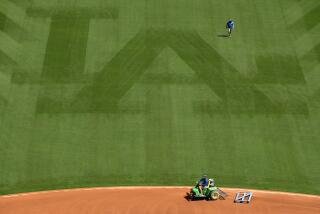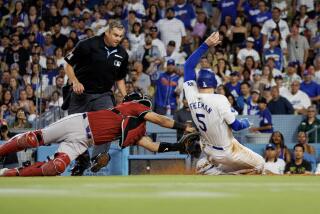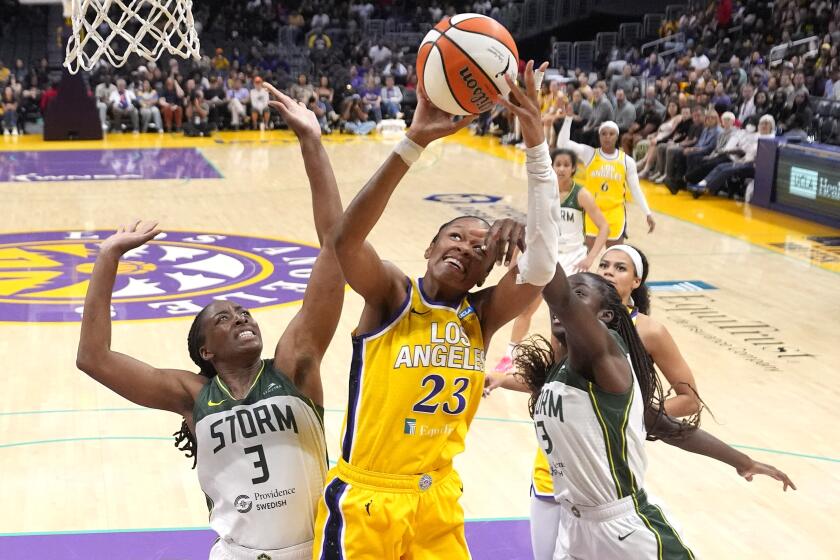National Passed Time
As major league baseball tries to pick up the pace of big league games, some radio and television stations say that squeezing commercials into half-inning breaks is getting as tough as squeezing a bunt down the third base line.
Major league baseball’s hurry-up approach to the slow-moving national pastime is working. A dozen rules now being enforced have helped shave the average time of National and American League games by six minutes from last year’s season average of nearly three hours.
But home viewers grumble that they’re now missing game action if clock-watching umpires occasionally signal “play ball” during radio and, occasionally, television, commercial breaks.
“We’d like fans not to miss a single pitch, and very few are being missed,” said Rich Levin, a spokesman for New York-based Major League Baseball. “But there are instances when it happens, and clubs are being instructed to make sure they’re conforming with the rules.”
Critics say that major league baseball is being disingenuous when it talks of shaving seconds off of games that still average close to two hours and 50 minutes. And, as critics note, major league baseball is more than willing to put its stopwatch on hold during nationally televised games when the half-inning break is lengthened by 20 seconds to two minutes and 25 seconds.
The rule establishing time limits on half-inning breaks has been on the books for several years. It’s designed to keep games moving by having batters step into the box exactly two minutes and five seconds after the last batter of the previous half-inning is called out.
Chicago-based Team Marketing Report estimates the Los Angeles Dodgers’ broadcast rights payments at $7 million per year. With that kind of revenue at stake, broadcasters “are going to want to fill the allotted time with ads,” said Team Marketing Report Editor Sean Brenner.
Each baseball club has the right to structure broadcasting deals as it sees fit. The San Diego Padres, for example, often air two 60-second commercials during a half-inning break. That leaves just five seconds of the 125-second half-inning window for announcers to squeeze in their half-inning wrap-up and set the table for upcoming action.
Fans grumble that Padre radio broadcasts too often miss action, as happened Tuesday night when fans missed the seconds leading up to Tony Gwynn’s lead-off homer in the eighth inning.
But Don Johnson, the Padres’ vice president of marketing, says that missed action during radio broadcasts “hasn’t been a major issue. We’ve had some calls from listeners, and we’ve had some discussions with our radio flagship station.”
Fans are less likely to miss game action because of a commercial overlap during radio broadcasts of Dodger and Anaheim Angels games because the teams limit commercial content during half-inning breaks to less than 100 seconds--20 less than the Padres.
Team executives say the broadcasts are structured to give booth announcers time to provide the “chatter” that many fans enjoy. But even with the added buffer, game action can get lost in the commercial shuffle.
That was the case last Sunday, when announcer Vin Scully sang “Take Me Out to the Ballgame” as a tribute to recently deceased Chicago Cubs broadcaster Harry Caray.
“As a result of that, we were late coming back to the game,” said Brent Shyer, the Dodgers’ director of broadcasting. “But that was an isolated thing. We don’t want commercials bumping into our games and we haven’t had any complaints.”
Major league baseball maintains that it is monitoring broadcasts. “When it does happen, we’re going to go back and talk to the clubs to make sure they conform to the rule,” Levin said.
The half-inning break rule is just one of a dozen that baseball now has on its books to address fan complaints that games drag on needlessly. The regulations run from setting limits on the time a pitcher can take between pitches to ordering bat boys to keep extra lumber on hand in case a batter cracks his favorite bat.
“This is mainly for the fans,” Levin said. “Over the years we found ourselves with games approaching the three-hour mark. And if a game starts at 7:30 p.m. and isn’t over until 10:30, by the time you get out of the ballpark, it’s pretty late.”
(BEGIN TEXT OF INFOBOX / INFOGRAPHIC)
Play Faster Ball
Baseball is tinkering with one of its traditions--a leisurely pace that often slows the national pastime to a crawl. Games in the National and American leagues have been getting longer, but new rules have shaved six minutes off the games this season.
Under The Old Rules. . .
Average length of a nine-inning game in the American and National leagues:
American League (1997): 2:57
National League (1997): 2:48
Note: Minimum interval time between innings increased to two minutes in 1985.
The New Rules
Major league baseball has reduced the length of games by six minutes this season by enacting these rules:
* Breaks between innings are limited to two minutes and five seconds.
* Umpires are not to grant time for batters to step out of the batter’s box unless absolutely necessary.
* Pitchers have 12 seconds to pitch when the batter is in the box and ready to hit.
* Managers and coaches who leave the dugout for a second mound visit in the same inning must “quickly” name the relief pitcher who will enter the game.
* The announcements and entertainment between innings must conclude one minute and 40 seconds into the break.
* Pinch-hitters are now required to warm up before going to the on-deck circle.
Source: Major League Baseball
Researched by JENNIFER OLDHAM / Los Angeles Times
More to Read
Go beyond the scoreboard
Get the latest on L.A.'s teams in the daily Sports Report newsletter.
You may occasionally receive promotional content from the Los Angeles Times.










